Variation in interferon sensitivity and induction among strains of eastern equine encephalitis virus
- PMID: 16103182
- PMCID: PMC1193634
- DOI: 10.1128/JVI.79.17.11300-11310.2005
Variation in interferon sensitivity and induction among strains of eastern equine encephalitis virus
Abstract
Eastern equine encephalitis virus (EEEV) causes human encephalitis in North America (NA), but in South America (SA) it has rarely been associated with human disease, suggesting that SA strains are less virulent. To evaluate the hypothesis that this virulence difference is due to a greater ability of NA strains to evade innate immunity, we compared replication of NA and SA strains in Vero cells pretreated with interferon (IFN). Human IFN-alpha, -beta, and -gamma generally exhibited less effect on replication of NA than SA strains, supporting this hypothesis. In the murine model, no consistent difference in IFN induction was observed between NA and SA strains. After infection with most EEEV strains, higher viremia levels and shorter survival times were observed in mice deficient in IFN-alpha/beta receptors than in wild-type mice, suggesting that IFN-alpha/beta is important in controlling replication. In contrast, IFN-gamma receptor-deficient mice infected with NA and SA strains had similar viremia levels and mortality rates to those of wild-type mice, suggesting that IFN-gamma does not play a major role in murine protection. Mice pretreated with poly(I-C), a nonspecific IFN inducer, exhibited dose-dependent protection against fatal eastern equine encephalitis, further evidence that IFN is important in controlling disease. Overall, our in vivo results did not support the hypothesis that NA strains are more virulent in humans due to their greater ability to counteract the IFN response. However, further studies using a better model of human disease are needed to confirm the results of differential human IFN sensitivity obtained in our in vitro experiments.
Figures
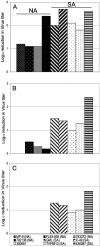

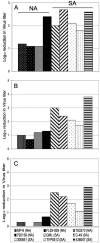
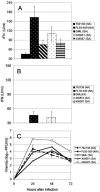

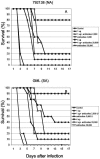
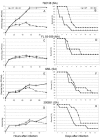

References
-
- Alice, J. F. 1956. Infeccao humana pelo virus “Leste” da encefalite equina. Bol. Inst. Biol. Bahia 3:3-9.
-
- Anishchenko, M., S. Paessler, I. Greene, P. V. Aguilar, A. S. Carrara, and S. C. Weaver. 2004. Generation and characterization of closely related epizootic and enzootic infectious cDNA clones for studying interferon sensitivity and emergence mechanisms of Venezuelan equine encephalitis. J. Virol. 78:1-8. - PMC - PubMed
-
- Baron, S. 1963. Mechanism of recovery from viral infection, p. 39-60. In L. M. Smith (ed.), Advances in virus research. Academic Press, Inc., New York, N.Y. - PubMed
-
- Baron, S., S. K. Tyring, W. R. Fleischmann, Jr., D. H. Coppenhaver, D. W. Niesel, G. R. Klimpel, G. J. Stanton, and T. K. Hughes. 1991. The interferons: mechanisms of action and clinical applications. JAMA 266:1375-1383. - PubMed
-
- Berge. 1975. International catalog of arboviruses. DHEW, Washington, D.C.
Publication types
MeSH terms
Substances
Grants and funding
LinkOut - more resources
Full Text Sources
Other Literature Sources
Molecular Biology Databases

